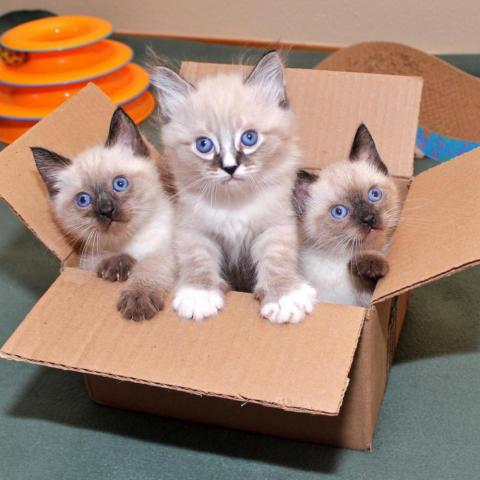Sổ Tay Chăm Sóc Mèo Con
Welcome to the kitten foster care program with MCAS. Every year the shelter takes in between 500 and 800 kittens. These are the shelter’s most at-risk pets as they are the most fragile, prone to illness and require the most individualized and consistent care. We rely on our foster families to help protect and care for these individuals until they are healthy, social and big enough to be altered and placed up for adoption. We ask that our foster families follow the guidelines outlined in this handbook to help make these animals’ experience the best and the safest that it can be. Fostering kittens is a lot of work, but it is also very rewarding and there are hundreds of little lives depending on families like yours.
Thank you from the MCAS team for becoming a foster parent!
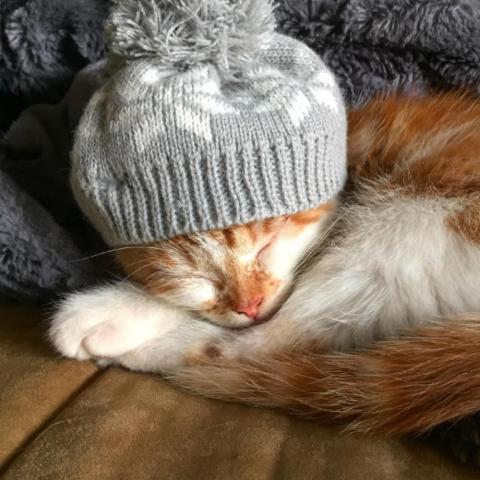
Table of Contents
- Notification
- Pickup
- Follow-up Appointments
- Surgery
- Adoption
- Feeding
- Cleaning Up
- Learning About the Litter Box
- Life Skills
- Getting Ready
- Bottle Feeding
- Syringe Feeding
- Burping
- Elimination
- Environment
- Hypoglycemia (Low Blood Sugar)
- Overall Health
- Feeding Tips and Tricks
- A Space For Mom
- Understanding Her Behaviors
- Maternal Neglect
- Not Using the Litter Box
- Rough Play
- Scratching the Furniture
- Set-up
- Handling
- Picking Up
- Moving Towards Adoption
- Are They Ready?
- Diarrhea
- Vomiting
- Upper Respiratory Infections (URI)
- Fleas
- Ear Mites
- Lice
- Ringworm
- For emergencies between the hours of 8AM and 5:30PM
- For emergencies between the hours of 5:30PM and 8AM
- Not Immediately Concerning - Appropriate to monitor
- Non-Emergency - Contact Animal Health at foster-medical-help@multco.us to see if an appointment is needed.
- Emergency
- Can I let my foster kittens interact with my personal pets?
- How much time will I need to dedicate to fostering kittens?
- Are you prepared to work with our veterinary team?
- How long will I be fostering each group of kittens?
- What are the common reasons that kittens need fostering?
- What should I do if my foster kitten bites someone?
- What if I want to adopt one of my foster kittens?
- What if one of my friends or family members wants to adopt?
- How do I get started?
Fostering Process
Notification
A request for the cats and kittens that are in need of foster will be sent out in an email as the need arises but generally once or twice a week. Interested parties can respond to the email or call the Foster Coordinator.
The Foster Coordinator will also maintain a list of open foster homes to contact directly when a match comes up. Please notify the Foster Coordinator of any particular interest.
Pickup
You will make an appointment with the Foster Coordinator to pick up the kittens and notify them of the need for any supplies. Bring your carrier with you and check in at the front counter when you arrive.
You will be asked to sign a foster agreement and be provided with paperwork including medical records, medications, a tracking sheet, and any other supplies that you needed.
Follow-up Appointments
Generally speaking, kittens will need an appointment about every three weeks. We attempt to schedule these at your preceding visit. Please contact Animal Health, at foster-medical-help@multco.us to schedule these appointments.
Surgery
Your kittens will be ready for their spay or neuter appointment when they are both eight weeks old and at least two pounds.
Surgery is generally offered Monday through Friday. You will drop off between 7:30 and 8AM and if they are returning to the foster home, they can be picked up between 4:30 and 5PM the same day.
Kittens should have their food withdrawn by 6AM the day of surgery to prevent stomach upset.
Adoption
We encourage you to network your kittens and find adopters through social media, friends and family. If you are not able to find an adopter through those methods one of the three following plans should be utilized.
- Kittens may stay after surgery for adoption at MCAS.
- Kittens may return to the foster parent’s home after surgery and be listed for adoption from there. You will be responsible for showing the kittens to potential adopters.
- Kittens may be transferred to another agency or hosted at one of our permanent outreach locations.
You should notify the Foster Coordinator at least one week prior to surgery with the desired adoption plan. Please note that the Foster Coordinator may not be able to accommodate all requests. For kittens that will need to be listed for adoption, send the Foster Coordinator a clear photo and a biography for each of your kittens prior to their surgery date.
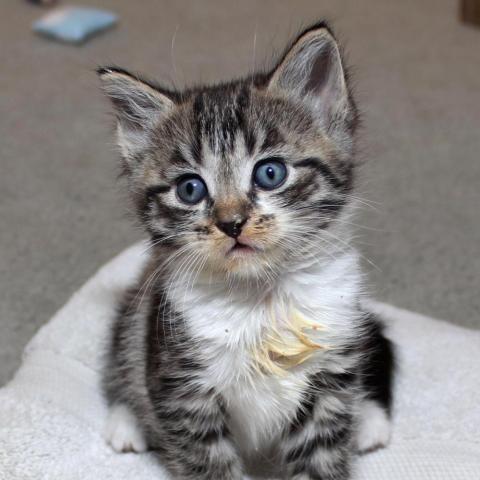
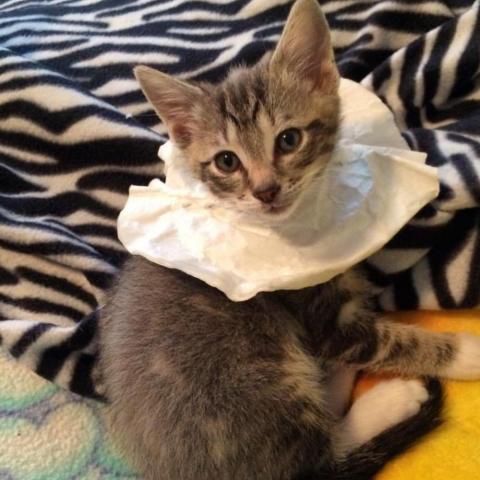
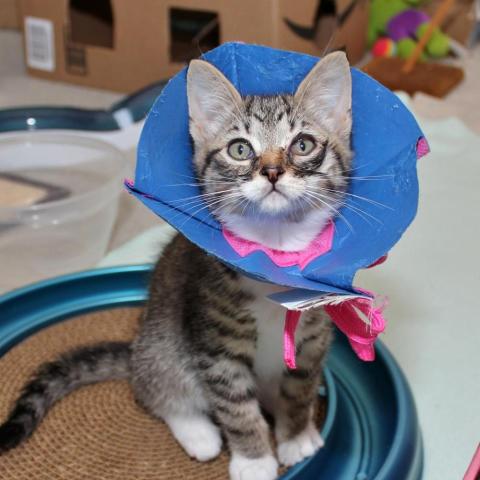
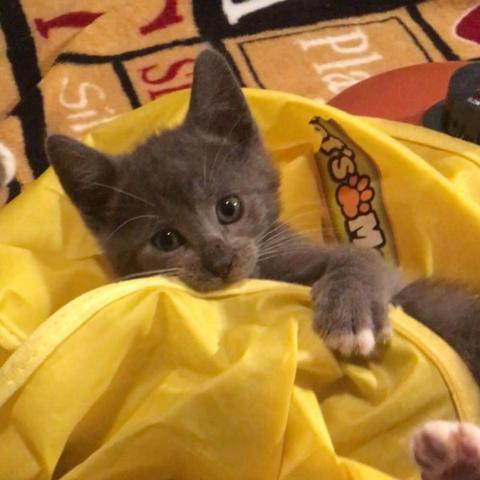
The Basics
Feeding
Moms and all weaned kittens under the age of six months should have access to dry kibble that is formulated specifically for kittens. MCAS will make an effort to provide this food for you but there are times when this is not possible.
Moms and kittens over the age of three weeks should be offered canned food daily in accordance with the guidelines in the Kitten Development Chart. All cats and weaned kittens should have access to fresh water at all time.
Cleaning Up
Kittens can be messy as they learn about eating and using the litter box. If a kitten is dirty, it is best to use a warm, damp cloth to spot clean them. This is both safe and more natural for them as this mimics the feelings of how their mother would bathe them. If you absolutely must give them a full bath, use warm water and make sure that they are completely dry before leaving them. You can use a blow dryer on the lowest setting or place them on a heating pad on a low setting to help them dry.
Prior to bringing home a new litter of kittens, it is important to clean your foster space. You will want to use a 1 part bleach to 32 parts cold water mixture to wash any hard surfaces including walls and floors. Food bowls, hard toys and litter boxes should be soaked in the solution for a minimum of 10 minutes. Any soft materials, such as towels, rugs and blankets, should be washed on a high temperature with bleach. Any cardboard or other items that cannot be washed should be discarded. Kittens should only be given access to surfaces that can be disinfected with bleach or discarded. Areas that cannot be disinfected could hold onto germs that could be spread to other animals or even people. Carpet cannot be properly disinfected and we strongly discourage allowing foster kittens to have access to it.
Learning About the Litter Box
Kittens may need your help learning good litter box habits. You can help them learn these skills by placing them in the litter box immediately after eating.
Kittens four weeks and older should have access to a low-sided litter box. The litter should be unscented and non-clumping as these can be harmful to young kittens if they accidentally ingest it. Cake pans, metal disposable cooking pans or cardboard trays work well. The litter box should be as far away from food and bedding as possible and it should be scooped at least two times a day. If you have a large group, it may need to be cleaned more often or they may need more than one.
Life Skills
Spend time with your kittens! Generally, we recommend at least one hour of time spread throughout the day in at least three separate sessions. Kittens should be socialized to a variety of people. Set the goal of having them meet seven to ten new people while you have them.
You can also spend quiet time with them. For example, read to them or quietly to yourself, or watch a movie. Expose them to the sights and sounds they will experience in their adoptive homes. You should also prepare them for the more challenging things that they will face. For example, practice gently holding their feet to practice nail trims or use food or toys to go in and out of a crate.
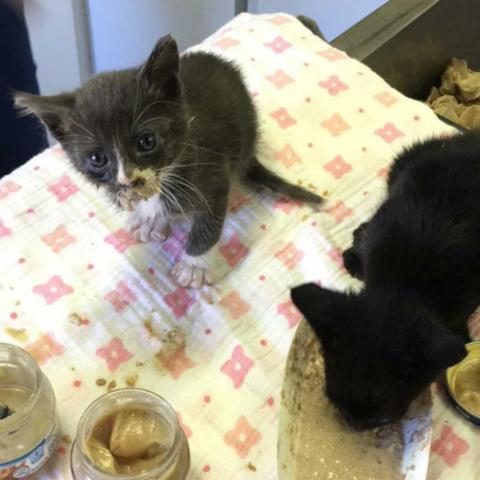

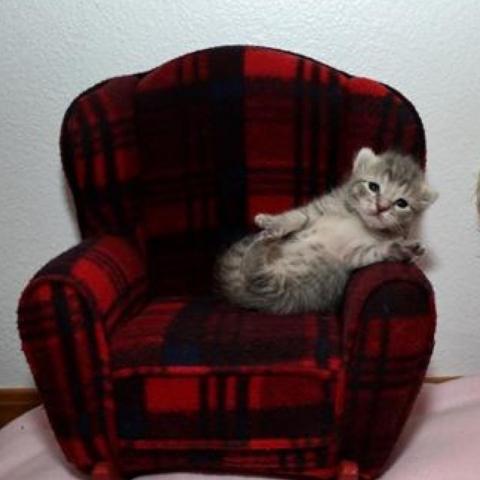
Setting Up Your Foster Space
Setting up your foster space to allow for easy clean up and a safe play area will make fostering easier and more fun. This is an example of a well set up space with some tips to consider when picking your own space.
- A safe place for sleeping and hiding. Their crate with the front door removed works well.
- Secured windows and closed toilet lids
- Appropriately sized litter boxes that are cleaned daily and contain non-clumping and non-clumping litter. Multiple may be needed for large litters.
- A scratching post or pad
- Lots of safe toys!
- Food and water that are fresh and as far from the litter boxes as possible.
- Separation from resident and other foster pets.
- Free from items that might be harmful to playful and curious kittens
- Regulated temperature
- Surfaces that are easy to clean and sanitize between litters and when there are accidents
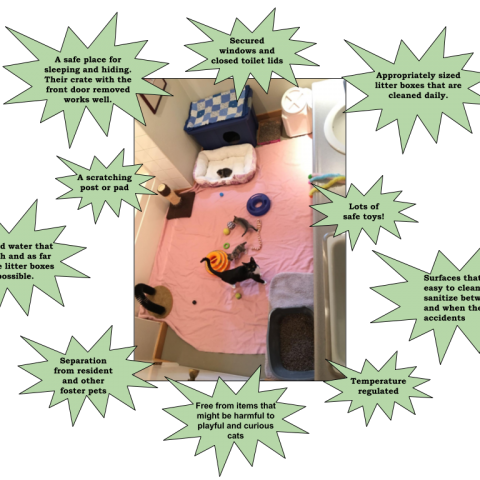
Kitten Development Chart
|
Age (wk) |
Wt. |
Feeding Instructions |
Average Development |
|
0-1 |
.25 lb. |
Monitor that mom is nursing everyone. If any of the kittens seem in distress, this could mean that they are hungry and may need additional feeding. |
Kittens will spend most of the day eating and sleeping. They cannot hear or see yet. They are reliant on their mother or you for warmth, food and assistance with elimination. Handling should be limited. |
|
1-2 |
.4 lb. |
Kittens will continue to gain all nutrition from the mother or formula. |
Kittens will start to move around and their eyes and ears will begin to open. All kittens’ eyes are blue at this stage and they are not fully developed yet. They remain unable to regulate their own body heat. |
|
2-3 |
.6 lb. |
Kittens will continue to gain all nutrition from the mother or formula. |
Kittens will begin to stand and move around more efficiently. They will begin to play with each other. Gentle handling should happen about an hour a day and be divided into several sessions. Kittens remain unable to maintain their own body heat. |
|
3-4 |
.8 lb. |
Kittens will continue to gain all nutrition from the mother or formula. |
Kittens will begin to see well; they may start grooming themselves and begin to show interest in the litter box. They have developed incisor teeth. Kittens still need one more week before they can regulate their own body heat. |
|
4-5 |
1 lb. |
Kittens begin to wean.. Refer to the “Weaning Kittens” page for specifics. |
Kittens should begin litter box training. They will be confidently walking and playing. They will be growing premolars |
|
5-6 |
1.5 lb. |
Kittens should be fed four small (one Tbsp) meals of gruel per kitten per day. |
The kittens are beginning to play more efficiently. They can wander away from mom now with supervision and she will begin to spend more time away from them. Begin socialization process. |
|
6-7 |
1.7 lb. |
Feed canned food at least three (one Tbsp) meals a day and have fresh, dry food at all times. Watch for any guarding of food and add another feeding station if needed. |
Kittens are becoming “tiny cats” and are moving efficiently. Continue practice with the litter box. They will begin to show their adult eye colors and have molars. |
|
7-8 |
1.9 lb. |
Offer canned food three times daily and have fresh dry food available at all times. |
Continue to socialize, play, and enjoy. |
|
8+ |
2 lb.+ |
Offer canned food two times a day and have fresh, dry food available at all times. |
Kittens are ready for altering and adoption once they reach two pounds. |
Bottle Baby Kittens
Bottle baby kittens are among the shelter’s most fragile guests and includes those that are only a few hours old when we hand them off to you. Our foster families are the ticket to these little ones’ survival.
Since our bottle babies require a bit more care, we ask that our fosters attend an additional class prior to taking them home. The class will provide some hands on practice and tips to help the journey be as smooth as possible. Contact the Foster Coordinator if you are interested in helping some bottle baby kittens.
Getting Ready
Kittens should be fed with a bottle that is made for kittens or a pet nurser. These bottles come with nipples that have not had a hole added to them yet. Use a hot needle to carefully poke a small hole in the top of the nipple. When the hole is the appropriate size, it should allow milk to come out in a slow drip without squeezing it. Watch the kittens closely as they are nursing. If milk comes out of their nose, the hole is too big and a new nipple should be used to prevent aspiration.
Formula should be warm, but not hot, and mixed according to the brand specifications. Test the temperature by dropping some on the inside of your wrist, where the skin is sensitive. You can warm the formula in a cup of hot water or a bottle warmer. Do not place the bottle directly in the microwave! Unused formula should be stored in the fridge and made fresh every one to two feedings.
Kittens should be fed a formula that is manufactured specifically for kittens. We can commonly provide these to you as needed. You should not make your own formula, or offer them cow’s milk or any other milk alternatives. These are life threatening to the kittens.
Bottle baby kittens have different needs at different life stages. The chart below provides a general guideline for frequency and quantity of feedings. Kittens who are not thriving or are struggling with other illnesses may need more frequent attention.
|
Age |
Weight |
Amount Per Feeding |
Frequency |
|
<1 week |
<5 oz. |
2-6 mL |
2 hours |
|
1-2 weeks |
5 oz.-9 oz. |
6-10 mL |
2-3 hours |
|
2-3 weeks |
9 oz.-12 oz. |
10-14 mL |
3-4 hours |
|
3-4 weeks |
12 oz.-1 lb. |
14-18 mL |
4-5 hours |
|
4-5 weeks |
1 lb.-1.2 lb. |
18-22 mL |
5-6 hours |
|
>5 weeks |
>1.2 lb. |
Weaning |
6 hours |
*Never feed a kitten who is cold! If the kitten’s temperature is less than 98°F, they should be warmed prior to offering food.
Bottle Feeding
- Place the kittens on their tummies with their heads slightly tilted up and their necks extended forward. The position should mimic how they would nurse if they were still with their mother. Never feed a kitten on their back like you would a human baby! This can cause aspiration.
- Hold their heads with your non-dominant hand. Place one finger gently on their throat to feel for them swallowing.
- Place the nipple in their mouths with your other hand. You may need to try this a few times before they accept it. Do not squeeze the bottle, but rather allow them to latch onto the nipple and begin nursing.
- The kitten should be allowed to nurse until they pull away from the bottle or until they have consumed an amount that is appropriate for their weight and age.
Syringe Feeding
Some kittens may struggle with the transition to bottle feeding. If you are unable to get a kitten to take a bottle, you can try syringe feeding. For syringe feeding, it is important to go very slow and make sure that the kitten is swallowing. Use a 1 mL syringe for young kittens and when you are new to the process. The small syringe makes it easier to measure the amount that the kittens are getting and it is easier to have a slow delivery of the formula.
Use the syringe to put a few drops of formula in the kitten’s mouth. Wait for them to swallow it and add a few more drops. Continue this process until they have received the appropriate amount of food according to their weight.
Some kittens will begin to latch on to the syringe. At this point, you can add a Miracle Nipple to the syringe and dispense the formula at the rate that they are nursing. Once your kitten is eating well with this method, you can switch out the syringe for a bottle.
Burping
After feeding your kittens, you will want to burp them. You can do this by rubbing their sides and stomachs or gently patting them on the back. You will not be able to hear it.
Elimination
Kittens under the age of three weeks of age will need assistance with elimination. Kittens should urinate after every meal and defecate once or twice a day. The mother cats normally do this by licking the ano-genital area. When the kittens do not have their mothers, they need our assistance. Use a soft tissue or warm, damp cloth to gently rub the kittens genitals in a circular motion. Continue this motion for a few extra seconds to allow the opportunity to defecate but keep it short to avoid causing irritation.
Observe the elimination for any abnormalities including blood or diarrhea. Urine that is dark in color may be an indication of dehydration. Stool should be brown to yellow in color and the consistency of soft-serve ice cream. Diarrhea can be exceptionally dangerous in kittens under the age of four weeks and Animal Health should be notified when diarrhea is first seen.
If your kitten has not defecated in more than two days, contact Animal Health for advice.
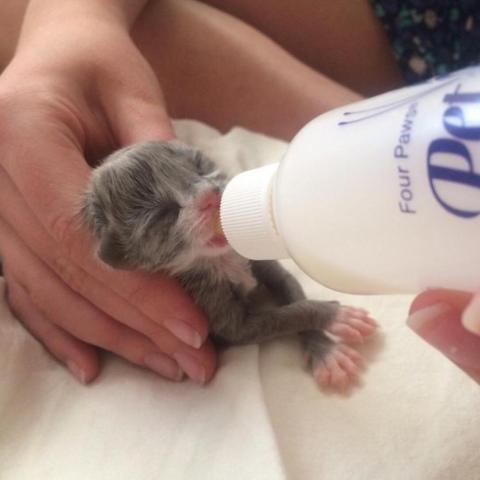
Aspiration Alert
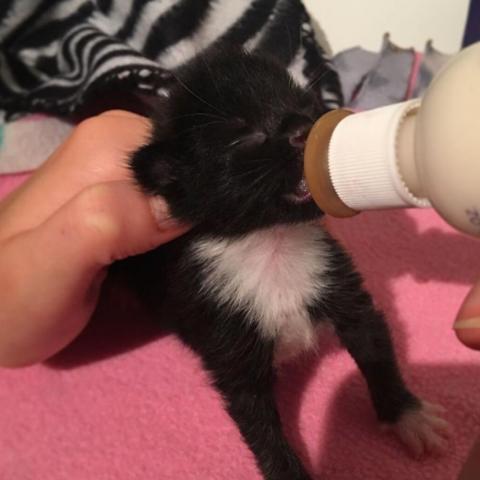
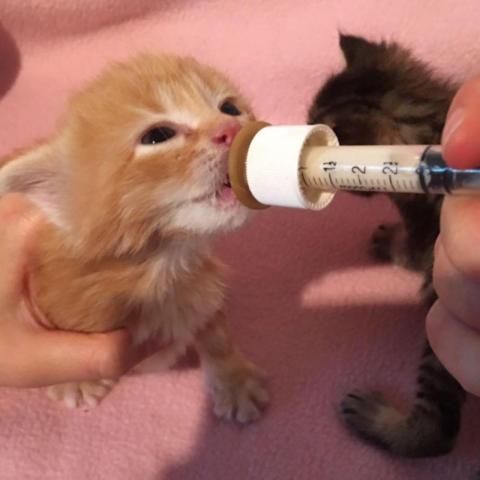
Environment
Keeping kittens warm is essential their health! They are unable to regulate their own body temperature until around five weeks of age and will need your help.
Ideal room temperatures:
- Birth to 7 days: 88° to 92°F
- 8 days to 14 days: 80° to 85°F
- 15 days to 28 days: 80°F
- 29 days to 35 days: 75°F
- Older than 35 days: 70°F
You can create a small space for them within this temperature range by placing a heating disk or a heating pad on the lowest setting only in a blanket-covered crate to contain the heat. A thermometer can be used to ensure the air temperature is adequate. It is important to use blankets or towels to cover the heat source to prevent burns and it should not cover the entire floor of the crate so the kittens are able to move away from it if they becomes too warm.
Hypoglycemia (Low Blood Sugar)
Hypoglycemia can happen in young kittens. It can present as a kitten that is cold to the touch, lethargic, or in respiratory distress. Begin by slowly warming the kitten. They must be warm for their bodies to absorb nutrients. If the kitten is extremely lethargic or collapsed, apply a small amount Karo or maple syrup to their gums every few minutes until they are more active and alert. This may take several hours. Contact Animal Health as soon as possible.
Overall Health
There are several ways that you can tell if your kittens are happy and healthy. In general, your kittens should sleep around 90% of the time the first two weeks. Kittens that are crying or restless may need more to eat or they may be struggling with an illness. Kittens should not be cold to the touch or withdrawing from the other kittens in the group. Contact the Animal Health team if you are experiencing any of these symptoms.
Feeding Tips and Tricks
- Wrap the kitten in a warm towel, leaving their head out and front feet loose enough to knead.
- Check the bottle to confirm that it is warm but not hot and that the flow is slow and not clogged.
- Cover one of the kitten’s eyes with your hand to help them focus.
- Gently rub the kitten’s forehead or back.
- If the kittens are less than 3 weeks old, try using a Miracle Nipple.
- Burp the kitten. Sometimes an air bubble can cause kittens to reject food.
- Potty the kitten. Some kittens prefer to go before a meal or they may just really need to go, causing discomfort.
- It is ok to skip one feeding if these do not work. Contact the Foster Coordinator if more than one feeding in a row is missed.
- Try syringe feeding. See instructions on page 11.
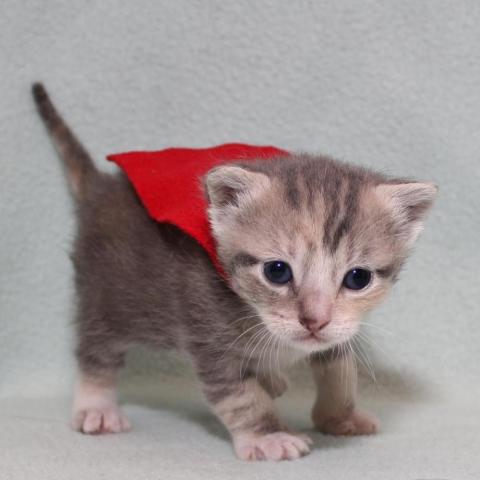
Weaning Kittens
The transition from mom’s milk or formula to dry food should take place over the course of a couple weeks. Every kitten is a little different on when they transition, but most should begin this process around four weeks and be at least mostly weaned by six weeks of age. Signs that they might be ready to wean, include biting at the bottle or showing interest in their mom’s food. Diarrhea is common in the weaning process, please refer the “Common Kitten Health Concerns” section for guidance on when to seek help.
- To begin, start with a gruel mix. This should be a smooth mixture of pate canned food and water. You may also add some single ingredient baby food or KMR to entice kittens’ interest as needed.
- Offer one dish of food per kitten. To encourage the kittens to eat, you can show them the food, use your fingers to place a small amount on their mouths or warm it up a little. If they show no interest try again in a few days.
- Over the course of the next week, gradually decrease the amount of liquid you add to the mixture so that it becomes more thick. Offer them food several times a day following the guidelines on the Kitten Development chart for quantity.
- Introduce a separate dish of dry kitten food and leave it with them at all times. You can grind it up with a food processor or wet it down to encourage interest. They should also always have access to fresh water.
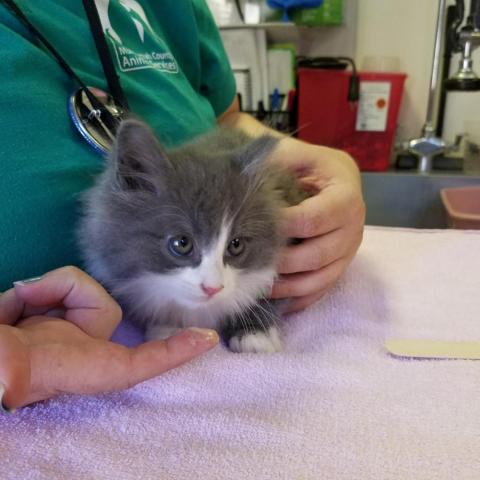
Mom and Kittens
Whenever possible, we want to keep mom and her unweaned kittens together. Having mom with the litter also makes the fostering process much easier because she will do most of the work for you! There are a few extra things to be aware of when you have the whole family though.
A Space For Mom
The mother and her family have been through a lot of transition in the time leading up to you bringing them home. She may be feeling a little anxious and unsettled. Create a quiet, warm, and safe space for her to settle in with her kittens. Keep interactions with her and the kittens to a minimum for the first several days.
Understanding Her Behaviors
Mom may feel a little more on edge or cranky than normal. Observe her body language for signs that she may need more space. Watch for tensing, swishing tail, dilated eyes, pinned ears, moving away, hissing or growling. She has an instinctual job to protect her family, and she may see you or other animals as a threat. Always keep other pets away from the mom and her babies and limit your contact with her if she is showing these sigs. Contact the Foster Coordinator if you feel unsafe or it does not improve over a week’s time.
Maternal Neglect
Maternal Neglect is when the mother is not caring for her kittens enough for them to thrive. They can suffer from hypothermia and may die if it is not caught. There are many reasons a mother may reject a kitten that are out of our control but one main cause is stress. As we mentioned, these guys are going to be under a lot of it. Things to watch for include, a mother who is never near the kittens, does not frequently groom or nurse them, or the kittens are crying and she does not respond to this. Contact the Foster Coordinator if you suspect maternal neglect.
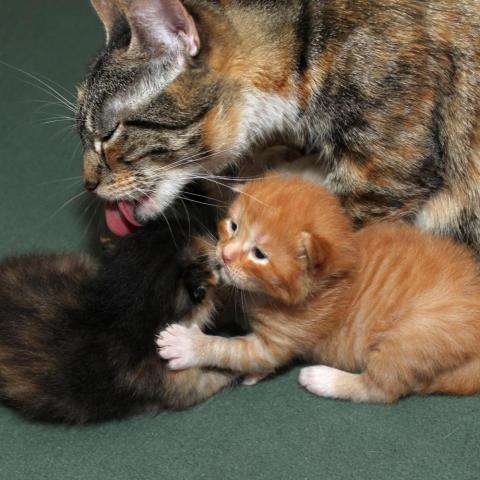
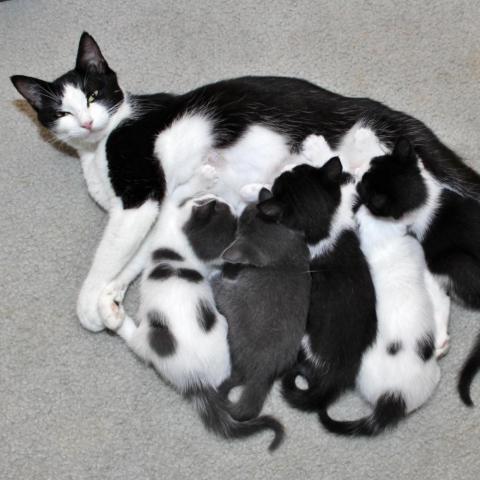
Common Behavior Concerns
Even with the best set-up and the most attention to detail, occasionally there are kittens that struggle with some behavior. Each kitten is unique but these tips are a great place to start. Start here, but if the problems continue, please contact the Foster Coordinator for further guidance.
Not Using the Litter Box
Most kittens learn how to use the litter box on their own but some need more help figuring it out. Litter box issues in kittens over the age of six weeks should have the following intervention plan to help kittens learn where to go.
- Provide extra litter boxes. Place them in the areas that the kittens are going.
- Scoop the litter boxes more often, some kittens are more picky about a soiled litter box.
- Try other kinds of litter. Set up several litter boxes with different options. Try clay, pellets, and potting soil. You can also try a special litter that attracts the kittens to it, called “Kitten Attract.”
- If the kittens are going on a particular item, remove that item from the room.
- If none of these changes are helping, try confining the kittens to a smaller space. A large dog crate works well. We can gradually increase their space once they have a better idea of the litter box.
- Ask for help from the Foster Coordinator if the problem continues despite intervention.
Rough Play
Kittens should be taught how to play without making contact with your hands. We never want to encourage kittens to bite, even gently. In order to encourage positive, safe play, use toys that move the kitten away from your body such as wand toys. When a kitten does bite or scratch you, make a loud “owe” sound and stop the play. You can resume play again after a few seconds.
Scratching the Furniture
Kittens should all be provided with appropriate surfaces to scratch and stretch. In the event that kittens are scratching on other surfaces, there are several options to deter them. To help the scratching post seem exciting, use toys to guide them to scratch on those places or try catnip for older kittens. You can also deter them from the undesired areas with double-sided sticky tape or by moving or covering that surface.

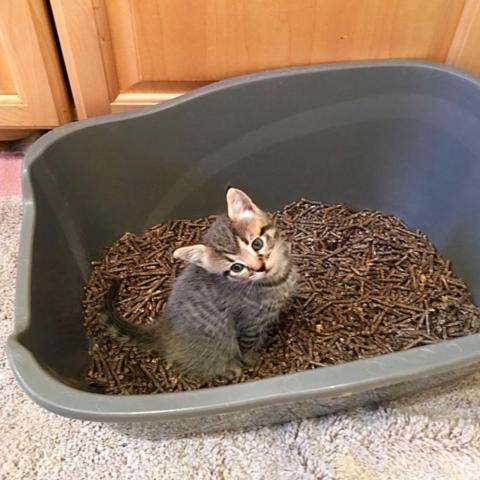
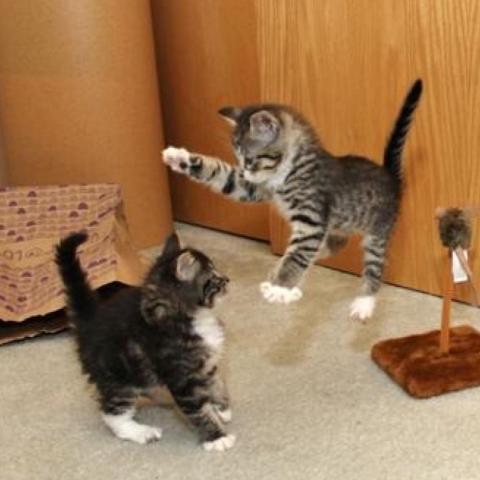
Confident Kitten Program
Some kittens that come to the shelter may have not been well-socialized with humans. These kittens will need some extra help gaining confidence before going up for adoption. The following program has proven quite successful and should be used on unsocial or undersocialized kittens. It is ideal when you can work with your kittens for several short sessions each day. Long sessions are not effective as they can overwhelm the kittens. If you find that you are not able to move through this process within about two weeks for kittens under three months old, please contact the Foster Coordinator. It is important to intervene at a young age.
Set-up
For your set-up, you will need to create a space where the kittens are not able to hide outside of your reach. A bathroom or a large kennel are generally good. The shelter can commonly provide a kennel if needed. Ideally, the kittens should be able to observe normal household noises and activities but not be completely overwhelmed by them. They should have some space to hide within the confinement to allow them the opportunity to take breaks from the commotion, but make sure you can still reach them.
Handling
Begin by assessing the degree of socialization of your kittens. Try offering them a small amount of food on your finger. If they will not come forward for this, you can try a spoon or a small amount in a dish while you sit with them. Move as far away as needed for them to come take a bite. Gradually decrease this distance at each session until they are eating out of your hand. Only have high value food out when you are working with them and pick it up when you leave. No free treats! Food is your friend. Meat-based, human baby food is the most likely to be successful, but you can also try canned cat food.
Continue to use the food on your fingers to gradually draw them closer to you and eventually into your lap. Slowly start to briefly touch them as they are eating in your lap or near you. As they become more comfortable with touch, start to work towards picking them up. You can touch their tummies and down their backs and gently start nudging them. If they struggle with being touched by a hand, you can try covering your hand with a small towel or wearing a soft glove.
Picking Up
Next, you can start to gently lift them a small amount off of the ground. Go slow, this is a new and weird feeling to them and a huge amount of trust is needed.
If your kittens are struggling with this step or you must hold them earlier than they are ready (for example, to medicate), you can begin by holding them in a small towel. You want to make a small burrito with the towel around the kitten. This will help the kitten feel secure but also keep you safe and get them used to their feet leaving the ground.
Moving Towards Adoption
Begin slowly handling the kitten without the food. This may be most effective at the end of a session where they are full and a little more sluggish.
Try to have new people work with them! They should begin to generalize that all people are good, not just you. This generally causes quite the set-back with them and may take a few visits. It is important though, as that adopter that comes to meet them will be a new person.
Continue to expose them to normal household sounds and commotion. Place their socialization crate in a more active room where they might be exposed to things such as the dishwasher and the TV.
Are They Ready?
Not all kittens are going to become social butterflies. An initial hiss, struggle, or disapproval of handling is not a concern and should not stop them from being adopted. Remember that the adopters want to take over and that the socialization process does not end when they leave your house!
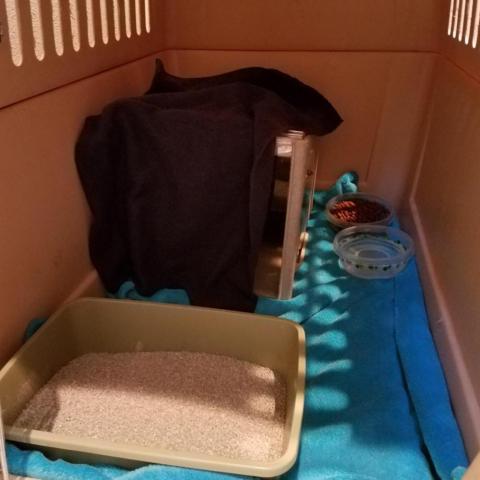
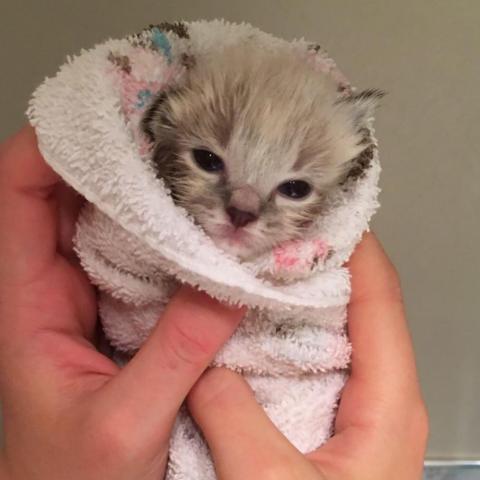
Common Kitten Health Concerns
All kittens will receive health exams before going into foster care and any known health concerns will be discussed with the foster parent. However, it is possible for symptoms to develop after the kittens are taken home. Because of this, it is very important to keep your foster kittens in a separate area, with separate bedding and without contact to your other household animals. MCAS is not responsible for treating any other animals in the foster home.
All kittens will be sent with an individual health tracking sheet. This sheet allows you to monitor kitten health status and it includes information about medications and future appointments. The sheet should be filled out daily and brought to all appointments and surgeries.
Diarrhea
Diarrhea is common in young kittens that have growing and sensitive bodies. Many things can cause diarrhea including a diet change while weaning.
If a kitten has diarrhea and is over four weeks of age, otherwise eating, acting normally, and gaining weight, then it is ok to monitor and give it a chance to resolve on its own for the first 24 hours. If the kitten is vomiting, losing weight, lethargic, inappetent or has unresolved diarrhea, then you should contact animal health for guidance. An appointment might be suggested.
Vomiting
Similar to diarrhea, vomiting has many causes. In some cases, a kitten may vomit from eating too rapidly. If you suspect this is the situation for your kitten, try offering smaller and more frequent meals.
If the kitten appears healthy otherwise and only has one or two vomiting episodes, then it is ok to keep an eye on it. However, if the kitten vomits more than twice, Animal Health should be contacted. Contact is also needed if the kitten also has diarrhea, weight loss, lethargy or a poor appetite.
Upper Respiratory Infections (URI)
URI is simply a kitten cold that is generally caused by a virus. The stress of being in a new environment or having surgery may make the kittens more susceptible to URI.
URI generally appears as sneezing, discharge from the eyes or nose, congestion and coughing, or swollen eyes.
Mild cases of URI do not need to be seen by a veterinarian. If the kitten has clear nasal discharge and is eating, gaining weight and otherwise acting normally, then an appointment may not be needed. Most mild URIs resolve on their own within seven to ten days. Animal Health should be contacted if the URI has not resolved or if the kitten has lethargy, poor appetite, weight loss, colored nasal discharge, severe congestion or a fever.
Fleas
Whenever possible, kittens will be treated for fleas before going to a foster home. In situations where the kitten is too young to receive flea medication, more conservative methods will be used such as combing and frequent bedding changes. Flea treatment should be applied monthly.
Ear Mites
When a kitten has ear mites, they will have crusty black debris in the ears. The ears are often itchy and may have a smell to them. Treatment is simple with medication. Sometimes, more than one treatment is needed to completely clear the ears.
Lice
Lice are rather uncommon in kittens in our area. Lice will look like white flecks on the kitten’s fur. Unlike dandruff that can be easily brushed away, lice eggs are stuck to the hairs and are not easily removed. A combination of a topical medication and combing will cure it. Cat lice is not contagious to humans. Contact Animal Health if you suspect your foster kitten has lice.
Ringworm
Ringworm is also rather uncommon in our area. It is a fungal infection that is commonly found on the head and legs of a kitten. The skin will look dry and the hair will be missing in these areas. Ringworm is treatable and typically involves medicated baths. Contact Animal Health if you suspect your foster kitten has ringworm.
It is expected that all veterinary care will be provided by MCAS or an approved emergency veterinarian under an emergency situation only. A foster parent may not take a foster pet to any other veterinarian. No medications, prescription or otherwise, are allowed to be given to foster pets unless previously authorized by MCAS veterinarian staff. Failure to follow this rule, may result in no longer being a foster parent with MCAS. Any unauthorized veterinary care will not be reimbursed by MCAS.
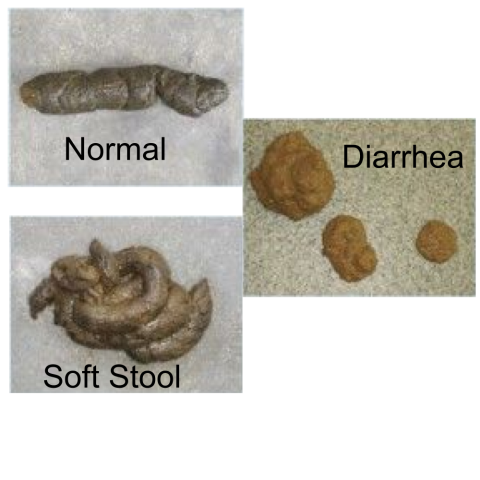
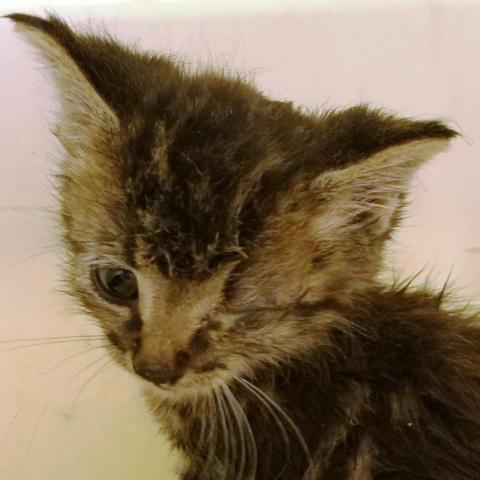
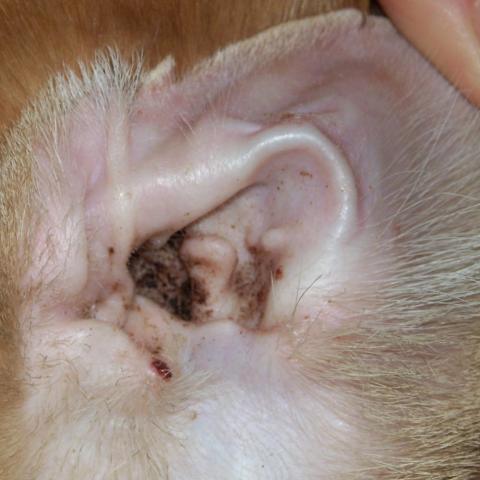

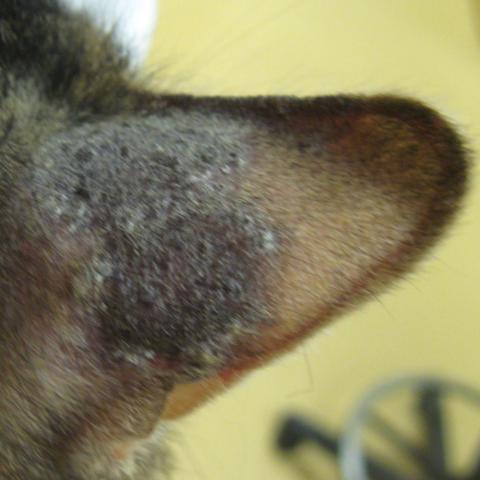
Emergencies
For emergencies between the hours of 8AM and 5:30PM:
- Email the medical team at foster-medical-help@multco.us and call 503-988-9075. Leave a message.
- Come to the shelter immediately! Do not wait for a response.
- Please have the animal ID number with you and provide this number at all points of contact whenever possible but do not let it delay you.
For emergencies between the hours of 5:30PM and 8AM:
- If you are feeling unsure if it is an emergency, refer to your foster contact sheet for a list of current foster mentors for guidance.
- Take the pet to an approved after-hours veterinary clinic.
Dove Lewis
1945 NW Pettygrove St
Portland, OR 97209
503-228-7281
- If possible, bring your foster’s medical records with you.
- Notify the clinic that this is a foster pet with MCAS and they will not charge you for the care they provide.
- Notify MCAS as soon as possible that you have taken an animal to an after-hours veterinarian via email at foster-medical-help@multco.us and a call to 503-988-9075. Please include the animal number.
Not Immediately Concerning - Appropriate to monitor |
|
Non-Emergency - Contact Animal Health at foster-medical-help@multco.us to see if an appointment is needed. |
|
Emergency - Requires immediate attention - See “Emergencies” on previous page for guidance |
|
Frequently Asked Questions (FAQ)
Q: Can I let my foster kittens interact with my personal pets?
A: We do the best we can to notify fosters parents of all known illnesses that a kitten may have. Unfortunately, they may be carrying a disease or parasite without showing symptoms for quite some time. We highly recommend keeping foster kittens and personal pets separate at all times. At a minimum, we recommend a two-week quarantine period. Personal pets must be up to date on vaccines, parasite preventatives and be healthy.
Q: How much time will I need to dedicate to fostering kittens?
A: Generally speaking, you should expect to spend between one and two hours a day with your kittens if they are weaned and up to eight hours a day for newborn bottle babies. This may vary with litter size, health, and degree of socialization. We also ask that our foster parents foster at least once a year to be considered an active volunteer.
Q: Are you prepared to work with our veterinary team?
A: As an MCAS foster parent, you will be required to work with our onsite veterinary staff for all routine care and emergencies that occur during the hours of 8AM and 5:30PM. This may mean several visits to our location throughout the time you have the foster kittens.
Q: How long will I be fostering each group of kittens?
A: Kittens will need to weigh two pounds and be healthy before they can be spayed/neutered and go up for adoption. This typically happens when they are about eight weeks of age, but it can vary with each kitten’s situation.
Q: What are the common reasons that kittens need fostering?
A: The majority of kittens just need time to grow until they are old enough to be spayed or neutered. Some kittens may also need socialization or specialized care for an illness or injury.
Q: What should I do if my foster kitten bites someone?
A: In the event that your kitten bites a person and the bite bleeds, you must contact the Foster Coordinator within 24 hours of the incident. It is required by law to have all bites documented and the animal quarantined. This includes bites that are non-aggressive in nature. The quarantine process is simple and requires that the kitten remain in your home or at the shelter for a 10 day period and be isolated from people and pets that they were not previously interacting with. We hope to avoid these situations whenever possible, but they do happen and we are here to support you and the kitten through the process.
Q: What if I want to adopt one of my foster kittens?
A: Foster caregivers may adopt a maximum of two of their foster kittens per litter. They will need to notify the Foster Coordinator, come to MCAS to complete the adoption application process, and pay the standard adoption fees. All kittens must be altered and up to date on vaccines prior to finalizing the adoption.
Q: What if one of my friends or family members wants to adopt?
A: Foster parents are encouraged to find adopters for their kittens through friends and family members or social media. The potential adopter should come to the shelter and meet with an adoption counselor after the kitten is fixed.
Q: How do I get started?
A: Attend an Informational Session! This is the first step for all MCAS volunteers. These are typically on the 4th Wednesday of the month from 7 to 8PM but you can confirm the dates and times on our website at multcopet.org/events.
Additional Resources
- www.aspcapro.org-A resource for a variety of topics regarding shelter animals and their care.
- www.maddiesfund.org-Another great resource for a wide variety of information including many how-to videos.
- www.kittenlady.org-The Kitten Lady has several videos for bottle and syringe feeding kittens.
- www.sfspca.org. Cat behavior library including great information regarding kitten socialization.
